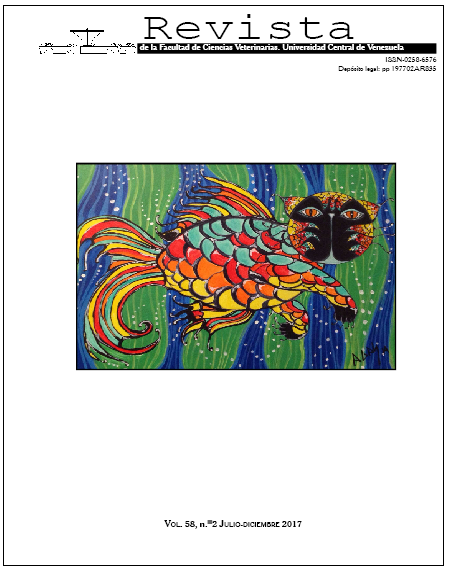Efecto Del Grupo Racial y Época sobre el Comportamiento Ingestivo y el Desempeño Productivo de Novillos Confinados Bajo Condiciones de Trópico Bajo
Contenido principal del artículo
Resumen
Con el objetivo de estudiar el efecto del grupo racial y la época sobre el comportamiento ingestivo diurno y desempeño productivo de novillos de tres grupos raciales manejados en confinamiento, se utilizaron 45 novillos de 260 (±10) kg de peso pertenecientes a tres grupos raciales: cebú colombiano (CC); cruce de CC por Aberdeen Angus (CA) y novillos mestizos (DP), provenientes del sistema de doble propósito de la zona. El estudio tuvo una duración de 150 d, y se estudiaron variables etológicas (tiempos de consumo de alimento, agua y mezcla mineral, descanso y rumia), y la ganancia diaria de peso (GDP) en época seca y lluviosa. La ración presentó una proporción de concentrado de 25%. Los animales DP dedicaron más tiempo (P<0,05) al consumo de alimento y al descanso en las dos épocas, y menos tiempo (P<0,05) a rumiar y beber agua, y a su vez, presentaron la mayor GDP (P<0,05). En los CC, el tiempo dedicado a caminar fue superior (P<0,05). Durante la época de lluvia los animales dedicaron más tiempo (P<0,05) a consumir alimento y a descansar, y menos tiempo (P<0,05) a rumiar y beber agua. La GDP fue de 0,960, 0,850 y 0,790 kg para los grupos DP, CA y CC, respectivamente. El grupo genético y la época climática influenciaron las variables estudiadas. El estudio de las variables etológicas permitió concluir que los novillos mestizos se adaptaron mejor al manejo en confinamiento, lo que se tradujo en una mayor GDP.
Effect of Racial Group and Season on Behavior and Gain Weight of Confined Steers under Tropical Conditions
Abstract
The study was carried in a farm located in Monteria, Colombia, to study the effect of racial group and season on the diurnal feeding behavior and performance of steers of three racial groups managed in confinement. Forty-five steers of 260 (±10) kg, of three racial groups were used: Colombian Zebu (CC); CC crossing by Aberdeen Angus (CA) and crossbred steers (DP), from the dual purpose of the region. The study lasted 150 days, and behavioral variables (times of: food, water and mineral mixture intake, rest and rumination), in dry and rainy seasons, and daily gain (ADG) were studied. The ration provided 25% of concentrate. The DP animals spent more time (P<0.05) feeding, in the two periods, and resting, and less time (P<0.05) ruminating and drinking water, and in turn they had the highest GDP (P<0.05). The time spent walking was higher (P<0.05) in the CC. During the rainy season the animals spent more time (P<0.05) feeding and resting and less time (P<0.05) ruminating and drinking water. The ADG was 0.960, 0.850 and 0.790 kg for DP, CA and CC groups, respectively. The genetic group and season influenced the variables studied. The study of the ethological variables allowed to conclude that the DP animals responded better handling in confinement, which resulted in higher ADG.

